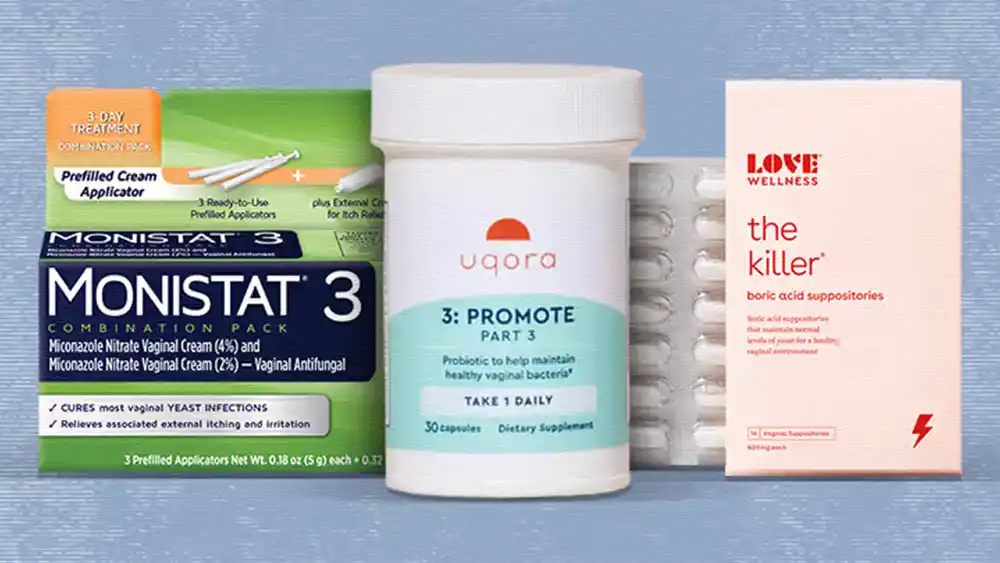
HEALTH NEWS
Right Medication for Vaginal Yeast Infections
-
Rahul Priydarss
Discover the right medications for vaginal yeast infections in this comprehensive guide. Explore over-the-counter and prescription-strength options, including common antifungal treatments like Miconazole and Clotrimazole. Learn about symptoms, causes, and factors contributing to yeast infections in the USA. Find expert advice on managing discomfort and restoring vaginal health effectively.
Introduction:
Dealing with the discomfort and inconvenience of a vaginal yeast infection can be frustrating. Thankfully, numerous medications are available to provide relief and restore vaginal health. In this guide, we’ll explore the different types of medications specifically designed to treat vaginal yeast infections, including over-the-counter and prescription options.
Understanding Vaginal Yeast Infections:
Vaginal yeast infections are caused by an overgrowth of Candida albicans, a type of fungus normally found in the vagina. Certain factors, such as antibiotic use, hormonal changes, and weakened immune systems, can disrupt the delicate balance of microorganisms in the vagina, leading to yeast overgrowth and the onset of symptoms.

Table of Contents
Symptoms of Vaginal Yeast Infection:
Common symptoms of a vaginal yeast infection include itching, burning, abnormal discharge, and redness or swelling of the vulva. While these infections are typically not serious, they can cause significant discomfort and require treatment to alleviate symptoms and prevent recurrence.
Vaginal Itching: Persistent itching in and around the vaginal area is one of the hallmark symptoms of a yeast infection. The itching may be mild to severe and can be accompanied by a burning sensation.
Vaginal Discharge: A thick, white, odorless discharge often accompanies a yeast infection. The discharge may resemble cottage cheese in texture and can increase in volume during the infection.
Redness and Swelling: The vulva and surrounding tissues may become inflamed, swollen, and red. This can contribute to discomfort and irritation.
Pain or Discomfort During Intercourse: Yeast infections can make sexual intercourse painful or uncomfortable due to inflammation and irritation of the vaginal tissues.
Burning Sensation: Some individuals may experience a burning sensation, particularly during urination or intercourse, which can exacerbate discomfort.
Soreness: The affected area may feel sore or tender to the touch, adding to the overall discomfort experienced during a yeast infection.
Over-the-Counter Antifungal Medications:
Over-the-counter (OTC) antifungal medications are often the first line of defense against vaginal yeast infections. These medications are available in various forms, including creams, ointments, suppositories, and tablets. Some of the most commonly used OTC antifungal medications include.
Miconazole (Monistat): Available in creams, suppositories, and ointments, miconazole is a go-to option for many women. It works by inhibiting the growth of Candida albicans, the fungus responsible for most yeast infections. Miconazole effectively relieves itching, burning, and other discomfort associated with vaginal yeast infections. Miconazole is another antifungal agent used to treat a variety of fungal skin infections. Like clotrimazole, it works by disrupting the cell membrane of the fungus, leading to its demise. Miconazole cream is applied topically to the affected area, usually twice a day for several weeks. It effectively relieves symptoms associated with fungal infections, including itching, burning, and inflammation.
Clotrimazole (Gyne-Lotrimin): Similar to miconazole, clotrimazole is available in cream and suppository forms. It functions by targeting yeast overgrowth, helping to restore the natural balance of microorganisms in the vaginal area. Clotrimazole is widely trusted for its efficacy and ease of use. Clotrimazole is an antifungal medication commonly used to treat fungal skin infections like athlete’s foot, jock itch, and ringworm. It works by disrupting the cell membrane of the fungus, leading to its death. Clotrimazole cream is usually applied directly to the affected area, typically twice a day for several weeks, until the infection clears up. It relieves symptoms such as itching, redness, and irritation.
Tioconazole (Vagistat-1): Tioconazole stands out as a single-dose ointment, providing rapid relief from yeast infection symptoms. Its convenient application and quick action make it a popular choice for women seeking fast relief. Tioconazole effectively combats yeast overgrowth, offering relief from itching, burning, and discharge.
Butoconazole (Gynazole-1): For those preferring a single-dose suppository, butoconazole fits the bill. It is designed to effectively treat vaginal yeast infections with just one application. Butoconazole targets the underlying cause of yeast infections, providing relief from symptoms and promoting healing.
Terbinafine Cream: Terbinafine is a potent antifungal medication that works by inhibiting the growth of fungi. It is commonly used to treat athlete’s foot, jock itch, and ringworm. Terbinafine cream is applied topically to the affected area once or twice a day for a specified duration, as directed by a healthcare provider. It effectively relieves itching, burning, and other symptoms associated with fungal infections.

Prescription Based Antifungal Medications:
In cases of severe or recurrent vaginal yeast infections, healthcare providers may prescribe stronger antifungal medications that are not available over the counter. These prescription-strength treatments may come in the form of oral tablets, vaginal suppositories, or creams. Some of the most commonly prescribed prescription-strength antifungal medications include.
Fluconazole (Diflucan): Fluconazole is an oral antifungal medication renowned for its efficacy in treating vaginal yeast infections. By inhibiting the growth of yeast cells, it swiftly alleviates symptoms and resolves infections. Typically administered as a single dose, fluconazole may be prescribed in multiple doses for severe or recurrent infections.
Higher-Dose Miconazole or Clotrimazole: In cases where standard doses of miconazole or clotrimazole fail to provide relief, healthcare providers may opt for higher doses of these medications. Available in cream or suppository form, these prescription-strength treatments offer a more potent solution for combating persistent yeast infections.
Alternative Antifungal Agents: For rare instances when standard antifungal medications prove ineffective, healthcare providers may consider alternative antifungal agents. Examples include ketoconazole or terconazole, which offer alternative mechanisms of action to combat yeast overgrowth and restore vaginal health.
Ketoconazole: Ketoconazole is available in various forms, including oral tablets, creams, and shampoos. While it’s primarily used to treat fungal infections of the skin and nails, it can also be effective against vaginal yeast infections when other treatments have failed.
Terconazole (Terazol): Terconazole is available as a vaginal cream or suppository and is specifically formulated to treat vaginal yeast infections. It works by interfering with the synthesis of fungal cell membranes, effectively eradicating yeast overgrowth and relieving symptoms.
Itraconazole: Itraconazole is another oral antifungal medication that may be prescribed for severe or recurrent vaginal yeast infections. It’s typically used to treat systemic fungal infections but can also be effective against localized infections when other options are not suitable.
Nystatin: Nystatin is available in various forms, including creams, ointments, and vaginal tablets. It’s commonly used to treat yeast infections of the skin, mouth, and vagina by disrupting the cell walls of fungal organisms, leading to their destruction.
Why Vaginal Yeast Infection Spread in USA:
While vaginal yeast infections aren’t contagious, they are quite common in the United States, affecting roughly 75% of women at some point in their lives. Here’s a detailed breakdown of why they’re so prevalent.
1. Disruption of Vaginal Microbiome: The vagina maintains a healthy balance between yeast (fungus) and bacteria, primarily Lactobacillus. This balance keeps yeast species like Candida albicans in check. Antibiotics are a double-edged sword. While they combat infections, they can also wipe out good bacteria in the vagina. This disrupts the microbiome, allowing Candida to overgrow and trigger an infection.
2. Hormonal Fluctuations: A woman’s hormone levels fluctuate throughout her life. Estrogen, in particular, plays a significant role.During pregnancy, menstruation, and with birth control pills, estrogen levels can rise or fall. This hormonal shift can disturb the vaginal microbiome and favor yeast growth. Here’s a more specific look.
- Pregnancy: Increased estrogen levels during pregnancy can promote Candida growth.
- Menstruation: Hormonal changes before menstruation can create an environment conducive to yeast overgrowth.
- Birth Control Pills: Some birth control pills contain high doses of estrogen, which can disrupt the vaginal microbiome.
3. Underlying Medical Conditions: Certain medical conditions can indirectly increase the risk of yeast infections.
- Diabetes: Uncontrolled diabetes can lead to high blood sugar levels, promoting yeast growth in the vagina and throughout the body.
- Weakened Immune System: HIV/AIDS and other conditions that suppress the immune system can make women more susceptible to yeast infections.
4. Other Factors: Certain lifestyle habits can also play a role.
- Douching: Douching disrupts the natural balance of vaginal flora, potentially increasing the risk of yeast infections.
- Tight-fitting clothing: Trapping heat and moisture can create an environment favorable for yeast growth.
- Diet: A diet high in sugar may contribute to yeast overgrowth.
FAQs about Vaginal Yeast Infection:
A1: Vaginal yeast infections are primarily caused by an overgrowth of Candida albicans, a type of fungus normally found in the vagina. Factors such as antibiotic use, hormonal changes, and weakened immune systems can disrupt the vaginal microbiome, leading to yeast overgrowth and infection.
A2: Common symptoms include vaginal itching, abnormal discharge (often thick, white, and odorless), redness and swelling of the vulva, pain or discomfort during intercourse, burning sensation (especially during urination or intercourse), and soreness in the affected area.
A3: Over-the-counter antifungal medications, such as Miconazole (Monistat), Clotrimazole (Gyne-Lotrimin), Tioconazole (Vagistat-1), and Butoconazole (Gynazole-1), are commonly used to treat vaginal yeast infections. These medications are available in various forms like creams, suppositories, and ointments.
A4: If a vaginal yeast infection is severe or recurrent, healthcare providers may prescribe stronger antifungal medications that are not available over the counter. These prescription-strength treatments, such as Fluconazole (Diflucan), higher-dose Miconazole or Clotrimazole, and alternative antifungal agents like Ketoconazole, Terconazole, Itraconazole, or Nystatin, may be necessary for more stubborn infections.
A5: Vaginal yeast infections are prevalent in the United States due to factors such as disruptions in the vaginal microbiome caused by antibiotics, hormonal fluctuations (e.g., during pregnancy, menstruation, or with birth control pills), underlying medical conditions like diabetes or weakened immune systems, and certain lifestyle habits (e.g., douching, tight-fitting clothing, and a diet high in sugar). These factors can create an environment conducive to yeast overgrowth and infection.
-Please remember, to always consult with healthcare professionals or Doctors for personalised advice related to medical conditions.
Conclusion:
In conclusion, understanding the right medication for vaginal yeast infections is crucial for effectively managing and alleviating symptoms. Over-the-counter antifungal medications offer convenience and accessibility, providing relief from itching, burning, and abnormal discharge associated with yeast infections. Common options like Miconazole, Clotrimazole, Tioconazole, and Butoconazole are readily available and often the first line of defense against mild to moderate infections.




